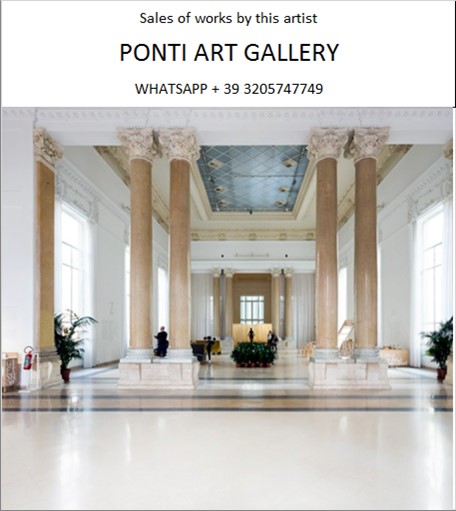Ponti Art Gallery is interested in buying and selling works
of art by this artist.

Frank Stella Biography
Frank Philip Stella, born on May 12, 1936, in Malden, Massachusetts, is an American painter, sculptor, and printmaker renowned for his contributions to the movements of minimalism and post-painterly abstraction. Stella's work is characterized by its non-representational style, emphasis on the materiality of the artwork, and the innovative use of color, shape, and form.
Stella's parents were first-generation Italian-Americans; his father was a gynecologist, and his mother, an artistically inclined housewife who painted landscapes. Stella's early exposure to art came from his mother and his education at Phillips Academy in Andover, Massachusetts, where he began painting under the tutelage of abstractionist Patrick Morgan. He continued his education at Princeton University, majoring in history while taking art courses with painter Stephen Greene and art historian William Seitz. These courses and his visits to New York galleries, where he encountered the works of Jackson Pollock, Franz Kline, and Jasper Johns, profoundly influenced his artistic development.
After graduating from Princeton in 1958, Stella moved to New York City, where he initially supported himself by painting houses. It was during this time that he began to create the works that would launch his career. His early "Black Paintings," characterized by their austere, monochromatic appearance and use of parallel stripes, were a stark departure from the gestural brushstrokes of Abstract Expressionism. These paintings, which included "The Marriage of Reason and Squalor, II" (1959), earned him immediate recognition and were included in the Museum of Modern Art's exhibition "Sixteen Americans" in 1959-60.
Throughout the 1960s, Stella's work evolved as he experimented with color and shaped canvases. His "Protractor" series, inspired by the circular measuring instrument, featured interlocking arcs and vibrant hues, reflecting his interest in color theory and geometric forms. This series marked a significant shift from his earlier minimalist work and showcased his ability to innovate within the realm of abstract art.
In the 1970s, Stella's work underwent another transformation as he began to incorporate relief into his paintings, leading to what he termed "maximalist" painting due to its sculptural qualities. His art became increasingly three-dimensional, and he started to use a variety of materials, including aluminum, fiberglass, and industrial paints. This period also saw Stella's engagement with printmaking, where he employed techniques such as lithography, screenprinting, etching, and offset lithography, further expanding his artistic repertoire.
The 1980s and 1990s brought about a series of works that responded to Herman Melville's "Moby Dick." These pieces, which included paintings, sculptures, and prints, were named after chapters in the novel and demonstrated Stella's continued interest in literary and cultural references. During this time, Stella's work became fully three-dimensional, with sculptural forms derived from cones, pillars, French curves, waves, and architectural elements. He utilized digital technologies and industrial equipment to create large-scale public sculptures and architectural projects.
Stella's career has been marked by numerous exhibitions and retrospectives, including a significant 2015 retrospective at the Whitney Museum of American Art that celebrated six decades of his work. His art is held in major collections worldwide, including the National Gallery of Art, Tate Modern, Art Institute of Chicago, Metropolitan Museum of Art, and Kunstmuseum Basel.
Throughout his career, Stella has been recognized with various awards and honors, including the National Medal of Arts. He has also given the prestigious Charles Eliot Norton Lectures at Harvard University. Stella's legacy is one of continuous innovation and exploration, pushing the boundaries of abstract art and influencing generations of artists. His work remains a testament to the power of abstraction and the endless possibilities of artistic expression.
Frank Stella Quotes and Sales
of Works
Ponti Art Gallery selects and deals with paintings by the
artist. Upon request, we provide free estimates and
evaluations, communicate prices, quotations, and current
market values.
If you are interested in BUYING or SELLING works by the
artist, contact us immediately.
If you wish to sell or receive an evaluation of the
works:
Send us a frontal photo of the painting, one of the back,
and one of the signature. Also, indicate the dimensions of
the work. Inform us about the purchase origin of the work
and any kind of available documentation (purchase
receipts, certificates of authenticity, publications). One
of our operators will respond to you on the same day. We
guarantee maximum confidentiality and extreme
professionalism.
If you wish to purchase works by the painter: Contact us
and let us know your request. We will inform you about the
available works. We also offer the possibility to
subscribe to our NEWSLETTER, through which you will be
informed at the beginning of each month about the latest
acquisitions of the art gallery.
You can send us pictures of the work:
